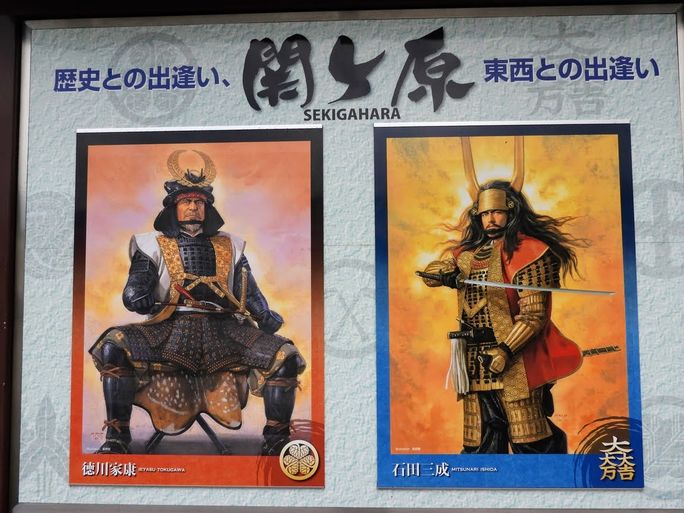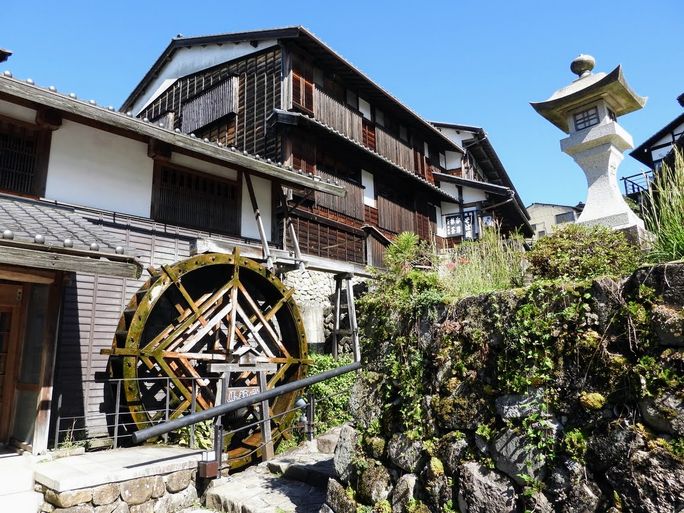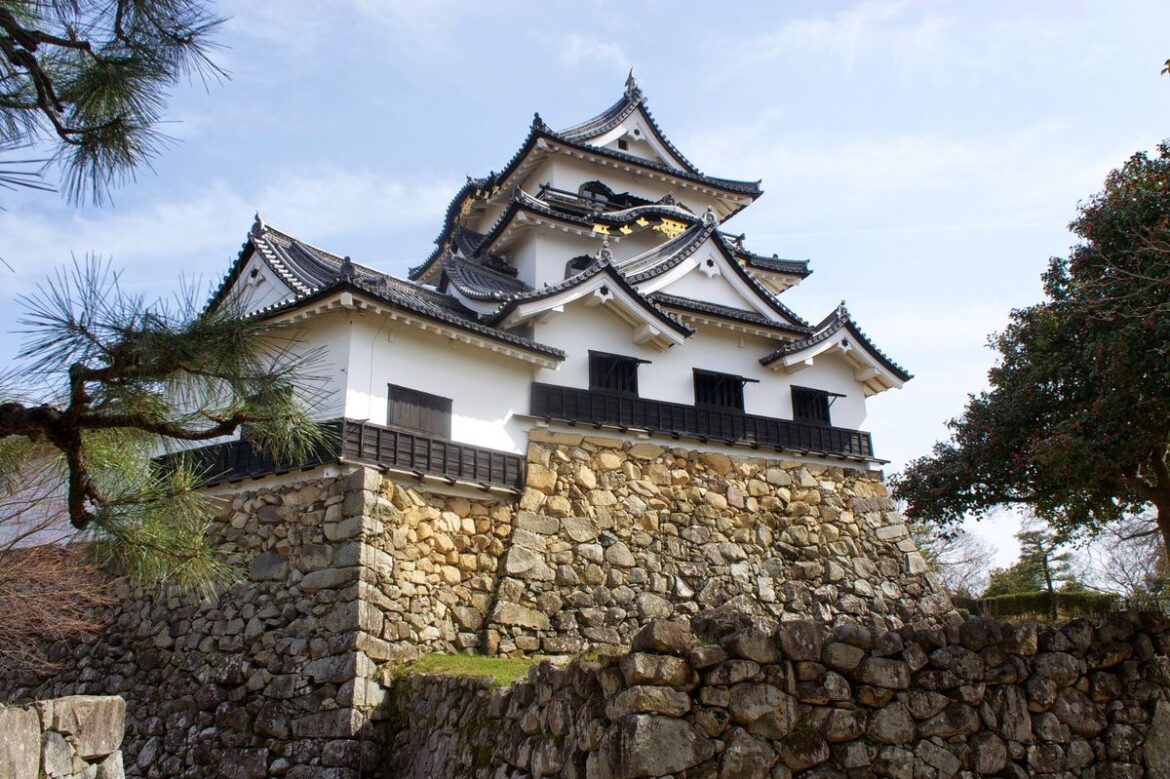 by Lucas Aykroyd
by Lucas Aykroyd
Last updated: 10:25 PM ET, Fri November 21, 2025
In 1600 AD, ferocious samurai warriors wield swords on a misty, mountain-ringed battlefield. The outcome will determine Japan’s fate for the next 260 years.
Fortunately, I’m not in the thick of this dramatic scene, rather watching as this big-screen production plays at a state-of-the-art museum in Sekigahara, the 1600 battle site. As a fan of the hit FX series Shogun, whose first season won a record-setting 18 Emmys, I’m thrilled to watch the animated film dedicated to the actual history behind it here at the museum. It’s another memorable stop on my Walk Japan group tour.

Poster at Sekigahara with rival warlords. (Photo Credit: Lucas Aykroyd/TravelPulse Canada)
Shogun’s popularity is one of many factors driving visitors to Japan. Safe, clean and affordable, the fabled Asian nation welcomed 36.8 million travellers last year – an all-time high – and was just named the number one destination for Conde Nast readers for the third consecutive year. For travel advisors seeking an authentic, off-the-beaten-path itinerary for clients into fitness, food and fascinating lore, Walk Japan’s Nakasendo Way tour delivers.
Related: Canadian Curiosity Fuels Growing Demand for Rural Japan, JNTO ReportsCastles, Artwork, and Feasts – On Foot
Nakasendo Way, including the forested Kiso Valley, spans 530 km between Kyoto and Tokyo. It became a key travel route for samurai, merchants and farmers during the Tokugawa Shogunate (1603-1868), the ruling dynasty founded by the fictionalized Lord Toranaga in Shogun. Interestingly, one route highlight is the beautifully preserved Hikone Castle, which appears as Toranaga’s castle in NBC’s 1980 Shogun series starring Richard Chamberlain.
Nowadays, Walk Japan tour participants cover one quarter of the Nakasendo Way on foot, hiking about 12 km per day.
“We are also known as Eat Japan – you get a lot of food!” quips Walk Japan guide Ines Rosan, a fluent Japanese speaker from Bordeaux who’s trained as a pastry chef.
Indeed, the day after Sekigahara, my group lunches on artistic sushi platters – honouring Princess Kazunomiya, the homesick teenage bride of a 19th-century Shogun – with Japanese radishes and local fish in Mitake. It’s one of 69 post towns on the route where travellers historically stopped to rest, eat and water their horses.

Artistically presented sushi in Mitake on a Walk Japan tour. (Photo Credit: Lucas Aykroyd/TravelPulse Canada)
The following night in Ena, I devour my dinner at Sagami Ena – a lively traditional Japanese restaurant – with fried pork with red miso paste, salmon sashimi and cold soba noodles. Rosan bridges the language gap, communicating with servers and describing the ingredients of each dish.
Ena also has the Nakasendo Hiroshige Museum of Art, showcasing the titular 19th-century Japanese artist’s 69 Stations of the Nakasendo. Vivid woodblock prints depict peasants, fishermen, watchtowers and mountains. Hiroshige’s sharp-lined illustrations remind me of Hergé, Tintin’s creator. I’m excited to learn that his style actually did influence the Belgian comic album author.
Journeys to Traditional Japanese Inns and Hot Springs
The varied terrain achieves its own artistic beauty. Each day, elevation changes range roughly between 350 and 740 metres. Winding dirt trails in dense forests, sidewalks in surreally tidy residential neighbourhoods and mountainside climbs up ishidatami (centuries-old paving stones) are among the Nakasendo Way’s many faces.

Hiking on the Nakasendo Way with Walk Japan. (Photo Credit: Lucas Aykroyd/TravelPulse Canada)
Persimmon trees, cute tanuki (Japanese raccoon dog) statues for good luck, Suzuki mini-trucks and spotless vending machines with cold brew coffee add to my 21st-century version of Shogun culture shock.
After a long day’s trek, bunking down at a traditional Japanese ryokan (inn) offers a welcome respite. In addition to elaborate dinners and breakfasts, served on low tables with guests seated on the floor, the bathing facilities and accommodations offer an authentic taste of Japan.
The pre-dinner ritual of soaking naked in a sex-segregated onsen (hot spring bath) and donning a yukata (dressing gown-like kimono) takes the edge off the huge daily step count.
I grow to relish the ryokan rooms. They typically feature pristine tatami (rice straw) mats, a rigorous shoes-off policy (plus special “toilet slippers” for the bathroom), tea-making supplies and comfortable futons with buckwheat pillows. Be aware of low doorways if, like me, you’re over six feet tall.
Shrines, Waterfalls, and Bullet Trains
Each step on the way to Tokyo brings new, soul-stirring sights. I explore a serene woodland Shinto shrine outside the hillside post town of Magome. A fanciful diorama in Tsumago with moon-dwelling rabbits making mochi balls makes me smile. The cascading, 100-metre-high glory of Karasawa Falls on the Kaida Plateau near Mt. Ontake is pure revitalization.

Picturesque Magome on the Nakasendo Way. (Photo Credit: Lucas Aykroyd/TravelPulse Canada)
And technically, this isn’t all about steps. If you tweak an ankle or fatigue sets in, Japan’s exemplary train system whisks you ahead to the next ryokan. Some longer Nakasendo Way legs are aboard the legendary Shinkansen (bullet train). I love the ultra-smooth, video game-like feeling of speed as we whiz through the countryside at more than 300 km/hour.
When our group reaches the Nakasendo Way’s terminus at Tokyo’s Nihonbashi Bridge, there’s an exhilarating feeling of accomplishment. I may not be Shogun, but I’ve sure come a long way.
Related: Why Everyone Is Traveling to Japan Right NowWhy Travel Advisors Should Recommend This Itinerary
“I’ve guided guests on the Nakasendo Way from ages 13 to 82,” Rosan says. It’s truly an inclusive, authentic, and environmentally friendly way to explore Japan beyond the big cities – while sampling incredible food and keeping fit. For solo travellers, longtime couples and anyone who values both culture and nature, this is an ideal itinerary. Participants should be in good health and comfortable with bag-handling, stair-climbing and daily walks representing various challenges.
More Guided Tours in Osaka, Nagoya, and Tokyo
Alternatively, to explore urban life in depth, InsideJapan Tours can curate exclusive private tours of Japanese cities, with flexible itineraries and fantastically detailed info-packs.
With guide Emma Holdsworth, I tour Osaka Castle of Shogun fame, wolf down Hiroshima-style okonomiyaki (a scrumptious cabbage-and-egg-laden pancake), and rock out in a private karaoke room.
Longtime Nagoya resident Serge Roso not only introduces me to Inuyama Castle (Japan’s oldest surviving wooden castle) and udon noodles in miso broth, but also explains nuances of Japanese life, from the lack of trash cans to the popularity of pachinko.

Red torii gates greet visitors to Inuyama Castle. (Photo Credit: Lucas Aykroyd/TravelPulse Canada)
Jocular Irish-born guide Fergal Fox introduces me to the gaming culture of Tokyo’s Akibahara neighbourhood – burgeoning with frenetic arcade drummers and statues of Nintendo’s Mario – and Sushiro’s excellent conveyor-belt sushi. (I keep the culinary party going later with Josh Fox of Arigato Travel, noshing on mouthwatering izakaya variations on chicken wings and yakitori.)
From the dazzling breakfast buffet and sleek onsen at Zentis Osaka to the complimentary non-alcoholic bubbly toasts and dog-friendly amenities at OMO5 Tokyo Gotanda, InsideJapan Tours also books guests into some luxurious, Lord-Toranaga-would-be-jealous hotels.
Related: JNTO Uncovers Japan’s Secrets
Topics From This Article to Explore


AloJapan.com